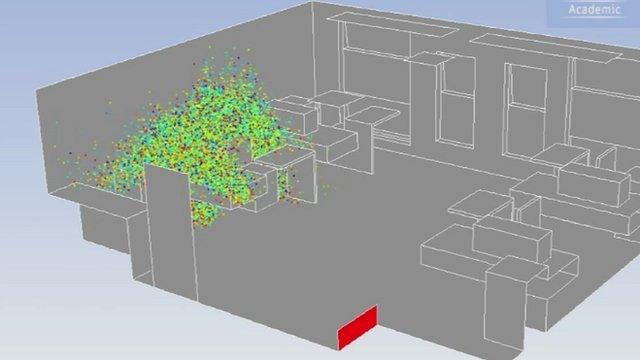Sneezes spray 'sheets, bags and strings' of fluid
- Published
Two subjects sneezed about 50 times for the experiments (Video: Bourouiba Group, MIT)
Researchers in the US have mapped out, for the first time, a striking sequence of shifting shapes found in the fluid we eject when we sneeze.
They used high-speed video footage to discover precisely how the stream of mucus and saliva breaks up into drops.
It moves in sheets, bursts, bags and beaded strings during this progression.
The process is important to understand because it determines the various sizes of the final droplets - a critical factor in how a sneeze spreads germs.
Modelling and helping to control that spread is the ultimate aim of the research, which was presented at a meeting, external of the American Physical Society's Division of Fluid Dynamics in Boston.
The work was led by Lydia Bourouiba, external from the Massachusetts Institute of Technology (MIT). She told the BBC that several other studies had measured the size of droplets produced by sneezes, but their results were variable because the first stage of the process was poorly understood.
"The part that is still a big unknown is: how are these drops actually formed and what is their size distribution? What I wanted to do was go upstream and look at the mouth, at what is coming out."
When she and her team studied the videos, they found themselves looking at much more than droplets at various sizes and stages.
"You see droplets, but you also see that the break-up process continues to happen outside the respiratory tract.
"Even more surprisingly, you see a process that cascades from sheets, to bag bursts, to ligaments, and then the ligaments destabilise into droplets."
Glorious detail
This procession of shapes has been observed in the flow of liquids in some industrial situations, Prof Bourouiba said, but was a surprise in this context.
"It was not clear at all that we would see that in a physiological fluid, and a physiological process like a sneeze," she said.

The team's previous work modelled the turbulent air flows created by a sneeze
With this knowledge under their belt, however, the scientists are much better equipped to model the formation of droplets of various sizes and to quantify what Prof Bourouiba calls the "footprint of contamination".
To improve that calculation further, she and her team are now using an array of nine high-speed cameras to capture sneeze dynamics in spectacular 3D detail.
"For the 2D analysis we just have two cameras - a side view and a top view. And when we did that assessment, we realised that there were very rich three-dimensional dynamics that we really needed to capture."
So at the conference, Prof Bourouiba offered a glimpse of the next stage.
"The work that we discussed today… shows the tools that we are developing in capturing the three-dimensionality of the sneezes in their full glory."
The plain old 2D analysis, including the already rather graphic video above, is due to be published soon in the journal Experiments in Fluids, external.
Follow Jonathan on Twitter, external
- Published9 September 2015
